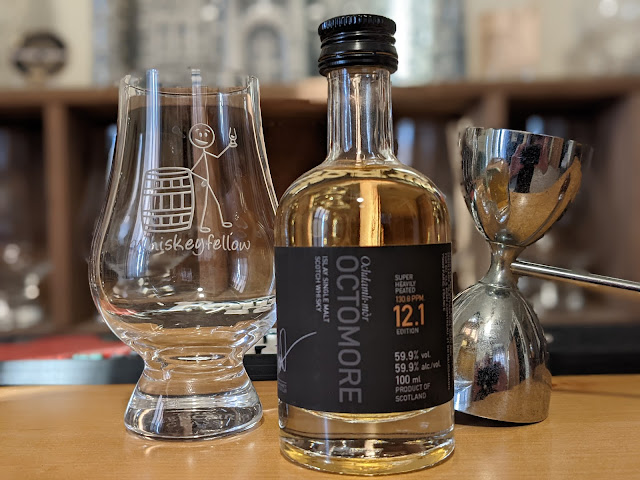Transparency is important.
It is one of the reasons I respect Bruichladdich
as much as I do. The distillery holds nearly nothing close to its vest and is
happy to publish as much information as possible.
It is also what I owe you,
the reader. If there’s a possible conflict of interest, you need to know about
it. For the last two years, I’ve been part of a group of influencers selected
to launch Octomore to the US market.
Last year, it was series 11, this year, series 12. Bruichladdich compensated me
to write content for the release of each. It also provided me with samples of
12.1, 12.2, and 12.3. Bruichladdich tasked me with putting together tasting
notes for 12.2. That leaves me with samples of 12.1 and 12.3 to review above and
beyond my now-completed assignment. Today, I’m sipping 12.1.
One thing that makes
Octomore special is that the entire concept should not work. Taking massive
peat levels and only aging it a handful of years and bottling it at near-cask strength
should have disastrous results. Instead, it comes together, forming something unique.
The annual x.1 release is
always the base whiskey. The other expressions are a variation of the x.1
theme. It begins with a 2014 harvest of Scottish-mainland concerto barley subjected
to the heaviest phenol content of peat of any other Scotch on the market. That
amount changes annually, and the 12th release is 130ppm. Octomore
12.1 rested five years in first-fill American oak on Islay. It is non-chill
filtered, naturally colored, and the only thing stopping it from being an
authentic cask-strength whiskey is adding a dash of Octomore spring water. It
weighs in at 59.9% ABV (119.8°), and you can expect to pay in the neighborhood
of $230.00 for a 750ml package.
Now, it is time to #DrinkCurious to explore what this is
all about.
Appearance: Served neat in my Glencairn glass, Octomore
12.1 was pale gold. It formed an ultra-thin rim that released medium-weighted
legs that crawled back to the pool.
Nose: As soon as I cracked the seal, there was no
mistaking that this is a super-heavily peated whisky. I might as well have
shoved my face into a freshly-extinguished campfire. I also let this one rest
for close to ten minutes before bringing the glass to my face. Shockingly,
getting past the smoke was effortless. I found lemon zest, coconut, marzipan,
toasted oak, and mushroom notes. Yes, the smoky peat was definitely there. When
I drew the air into my open mouth, an explosion of vanilla rolled across my
tongue.
Palate: I found the mouthfeel carried a medium body.
If I didn’t have previous experience with Octomore, I would have prepped myself
for chewing on charcoal. That doesn’t happen, and smoke isn’t even the first
note. Instead, the front featured dark-roast coffee, marzipan, and well-done
bacon. The middle became fruity with orange zest, plum, and apricot. The back
is where things came as you’d assume:
black pepper, burnt oak, and earthy peat.
Finish: This may be one of the longest finishes I’ve
experienced. I ran a stopwatch and clicked stop
at 5:29! Brine and orange zest were the
first qualities I picked out, followed by English toffee and charred oak. Spicy
ginger beer and peat smoke lingered, lasting the longest.
Bottle, Bar, or Bust: Octomore is unique, and I’ve yet to have one
that isn’t just dazzling. I love how the published peat content is scary, and a
whiskey that doesn’t work on paper performs gallantly in the glass. Yes, it is
pricy, but it is also something you can’t substitute with another whisky. Would I shell out $230.00 for it? I wouldn’t even bat an eye. Grab a Bottle if you see it; it is well worth
the cost of admission. Cheers!
My Simple, Easy to
Understand Rating System
- Bottle = Buy It
- Bar = Try It
- Bust = Leave It
Whiskeyfellow encourages
you to enjoy your whiskey as you see fit but begs you do so responsibly.

Where do you find this for $150? It's $230 direct from Bruichladdich.
ReplyDeleteWhen I wrote this, I based it upon the price of previous releases. I can tell you that, historically speaking, distilleries don't like to compete with their resellers and are often more expensive (without getting into secondary pricing). I've not seen 12.x on a store shelf yet (I'm in Wisconsin). I'd still pay $230 for this whisky, and I'm happy to revise the price to what the distillery sells it for. Thank you, cheers!
Delete